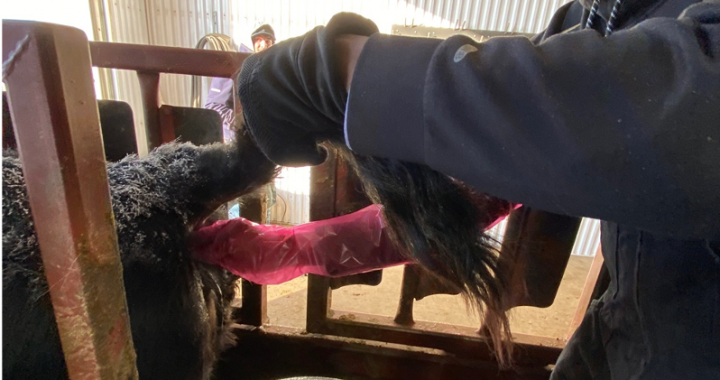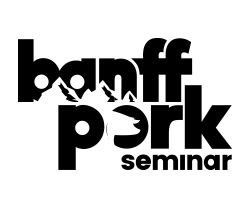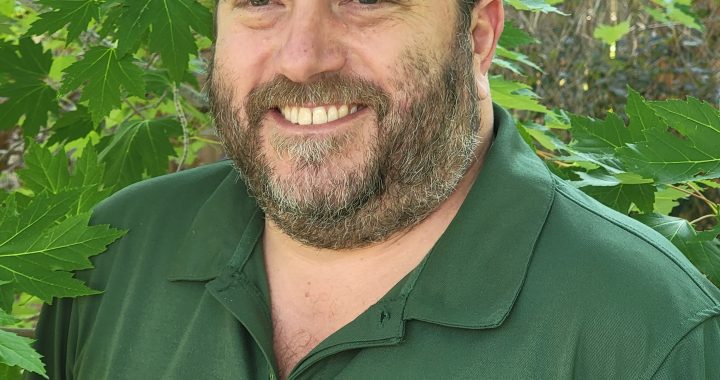Dalhousie University, Lakeland College and University of Alberta are conducting simultaneous feed efficiency and enteric emissions assessments on beef cattle. These trials are part of our NSERC-SSHRC funded project: “Using genomic tools to reduce GHG & Methane in beef cattle”. Feed efficiency is measured with GrowSafe® and enteric emissions are being measured with GreenFeed® emission monitoring systems. We have genotyped and we are collecting fecal samples from these animals during the trial. We aim to develop molecular breeding values and selection indexes for green house gas emissions and production efficiency with the project data. We will collect Near Infrared Spectra on the fecal samples to develop a low cost proxy phenotype for enteric emissions by using ML and AI tools for processing the data. We are also in the process of coordinating with collaborators on additional research sites to contribute to the project dataset.

Pictured: Obioha Durunna from Lakeland College collecting fecal samples by rectal palpation for later Near Infrared Spectroscopy.
The project: “Using genomics to improve the profitability and sustainability of Alberta’s beef industry” is funded by a grant awarded to Dr. John Basarab in 2024, funded by Sustainable CAP and administered by RDAR. In this project we are collecting key phenotypic data from producers and providing informative genomic value reports. These genomic value reports provide the following data: genomic breed composition, retained heterozygosity, molecular breeding values for 12 phenotypes, and Livestock Gentec’s Replacement Heifer Profit I ndexTM and the Feeder Profit IndexTM. Further, producers participating in the project can genotype their animals at a discount rate ($20/animal). The genotyping cost is shared between the project and Neogen our sequencing partner. In exchange for the discounted genotyping and genomic values report, participating producers are required to collect some basic phenotypic data from their herds to enhance our reference dataset. We have already collected over 9,000 genotypes in this project . If you are interested in participating, please see the QR codes to learn more and information to sign up. Please reach out to lsgentec@ualberta.ca if you have any questions.
Publications
Hailemariam, D., Manafiazar, G., Baes, C., Schenkel, F., Miglior, F., Stothard, P., Plastow, G. (2025) Circulating serum metabolites as biomarkers and predictors of residual feed intake in lactating dairy cows. Sci. Reports 15, 1709. https://doi.org/10.1038/s41598-025-85610-1
Hailemariam, D., Manafiazar, G., Baes, C., Schenkel, F., Miglior, F., Stothard, P., Plastow, G. (2025) Circulating serum metabolites as biomarkers and predictors of residual feed intake in lactating dairy cows. Sci. Reports 15, 1709. https://doi.org/10.1038/s41598-025-85610-1
Virtuoso, M.C.S., Aalhus, J.L., Juárez, M., López-Campos, O., Bruce, H.L., Li, C., Basarab, J.A., Plastow, G. Valente, T.S. (2025) Genetic parameters and genomic insights for meat colour traits of Canadian crossbred beef cattle. Can J. Anim. Sci. 105:1-13. doi.org/10.1139/cjas-2024-0074
Virtuoso, M.C.S., Aalhus, J.L., Juárez, M., López-Campos, O., Bruce, H.L., Li, C., Basarab, J.A., Plastow, G. Valente, T.S. (2025) Genetic parameters and genomic insights for meat colour traits of Canadian crossbred beef cattle. Can J. Anim. Sci. 105:1-13. doi.org/10.1139/cjas-2024-0074






















